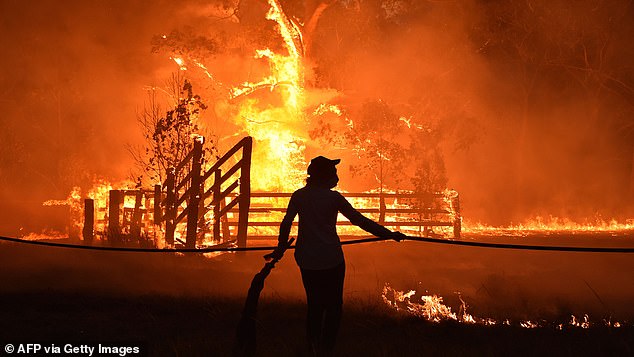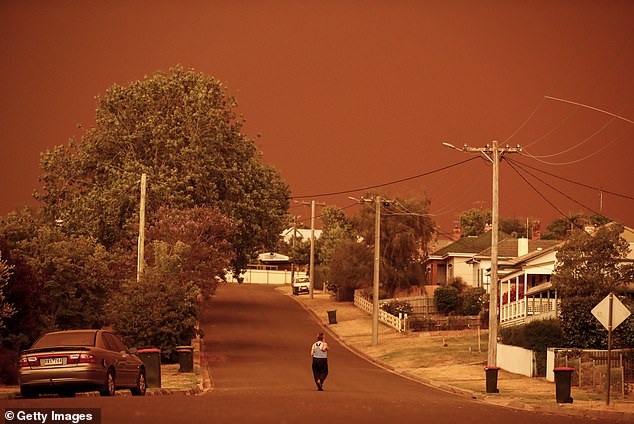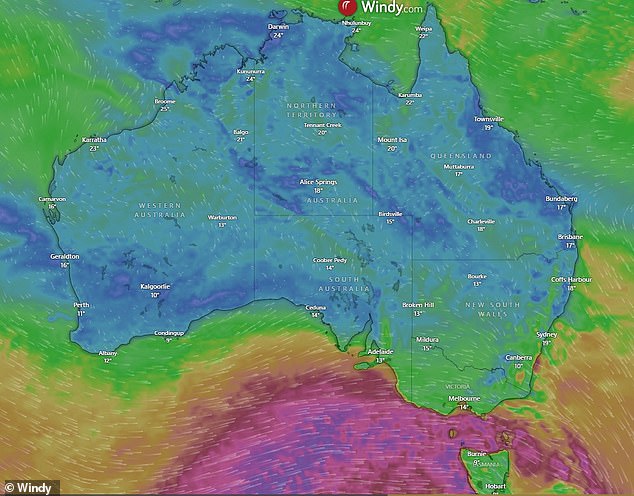NSW: Scorching winter heatwave sparks alarming early start to bushfire season as searing winds and record temperatures trigger deadly warning
The scorching winter heatwave combined with wind gusts of up to 100km/h has sparked a series of bushfires across New South Wales, with fire chiefs issuing an urgent warning to rural property owners.
More than a dozen bush and grass fires burned along the New South Wales south coast on Wednesday, with the Illawarra and Shoalhaven regions in the state’s southeast particularly hard hit.
Unusually high temperatures combined with strong winds of over 100km/h have fuelled the fires, prompting the NSW Rural Fire Service (RFS) to urge landlords to halt planned fires.
“Bush and grass fires can occur all year round, but today we saw very strong and gusty winds, particularly across the Greater Sydney region and in the Illawarra and Shoalhaven areas,” an RFS spokesperson told Daily Mail Australia.
‘That’s why you see a small forest fire there on the coast. Shoalhaven in particular has been quite busy since late last night.
“Trees and power lines have fallen and we’ve had a few cases of private landowners having re-burns caused by the wind.”
The spokesman urged landowners not to light “private hazard reduction fires”.
‘This is the time of year when we traditionally see a lot of landowners at work, and that’s great.
More than a dozen bush and grass fires broke out across the NSW south coast on Wednesday, with the Illawarra and Shoalhaven in the state’s south-east particularly hard hit (pictured)

Unseasonably high temperatures combined with strong winds of more than 100km/h have fuelled the fires as the NSW Rural Fire Service (RFS) has urged landlords to halt planned fires (pictured: Residents defend a property from a bushfire in Hillsville near Taree, 350km north of Sydney on November 12, 2019)
“But on days like today, we urge you to wait and not light any fires. The last thing we want is for the fires to get out of control and out of control, potentially threatening your home or your neighbors’ property.”
According to the RFS website, all fires are currently under control and there are no emergency warnings.
It comes as urgent weather warnings have been issued for five Australian states, with weather experts predicting that large parts of the country will be hit by devastating wind gusts.
Western Australia, New South Wales, Victoria, South Australia and Tasmania are all in the firing line of dangerous conditions on Wednesday, with rain in the forecast.
The Bureau of Meteorology has issued severe weather warnings for southeastern Australia, with possible wind gusts of up to 130km/h.
The windy conditions are the result of one of the coldest fronts of the year moving across the Southeast.

The RFS spokesperson urged landowners not to set ‘private hazard reduction burns’ (pictured: a woman looks out onto her street as the sky turns red from the fires on January 4, 2020 in Bruthen in East Gippsland, Victoria)
Conditions are expected to be so bad that Tim Wiebusch, head of the SES in Victoria, issued an urgent warning to residents on Tuesday.
“Victorians must take action now and prepare for what could be the strongest weather system we have seen in our state this winter,” he said.
“Please ensure you drive in appropriate conditions and be alert to the potential for fallen trees and debris on our roads over the next 36 hours.”
In NSW, an extreme weather warning has been issued for Sydney, Illawarra and parts of the Metropolitan, South Coast, Central Tablelands, Southern Tablelands, Snowy Mountains and Hunter Forecast Districts due to damaging wind gusts.
Damaging wind gusts averaging 60 to 70 km/h, peaking at around 100 km/h, are possible in parts of the Blue Mountains and western Sydney.
The Illawarra region is expected to experience an average wind speed of 70 to 80 km/h, with gusts of up to around 110 km/h. This wind force will decrease in the early evening.
Similar warnings have been issued in Victoria for the Central, East Gippsland, South West, West and South Gippsland weather districts and parts of North Central, North East, Wimmera and Northern Country.
BOM meteorologist Sarah Scully said the cold front would bring “very windy conditions and heavy showers and gales” to parts of southeastern Australia.
“New South Wales will be generally dry, but it will be a very windy day, with showers in the southern ranges,” she said.

Urgent weather warnings have been issued for five Australian states as much of the country faces devastating wind gusts

The windy conditions are accompanied by unusually warm temperatures for some parts of the country, with Brisbane set to be 8 degrees warmer than average on Wednesday, with a high of 31 degrees.
‘It will be noticeably windy, especially in Sydney and the Illawarra region.
‘It will also be a very windy day in Victoria, while South Australia will have a windy start to Wednesday, but the wind will ease during the afternoon.’
These windy conditions are accompanied by unusually warm temperatures for some parts of the country, with Brisbane expected to be 8 degrees warmer than average on Wednesday, with a high of 31 degrees.
Monday there is a a scorching 41.6C was recorded in Yampi Sound, in the northwest Western Australia – Highest winter temperature ever recorded in Australia.
The Bureau predicts the higher temperatures will continue throughout the week, with some areas seeing temperatures as much as 11 degrees higher than the late winter average.
